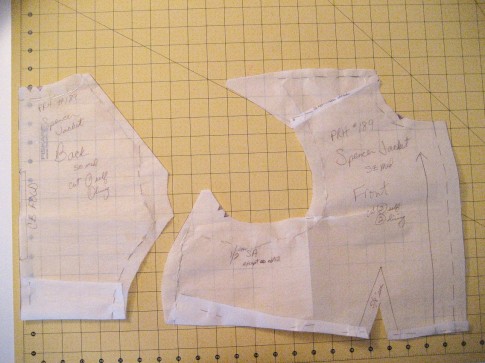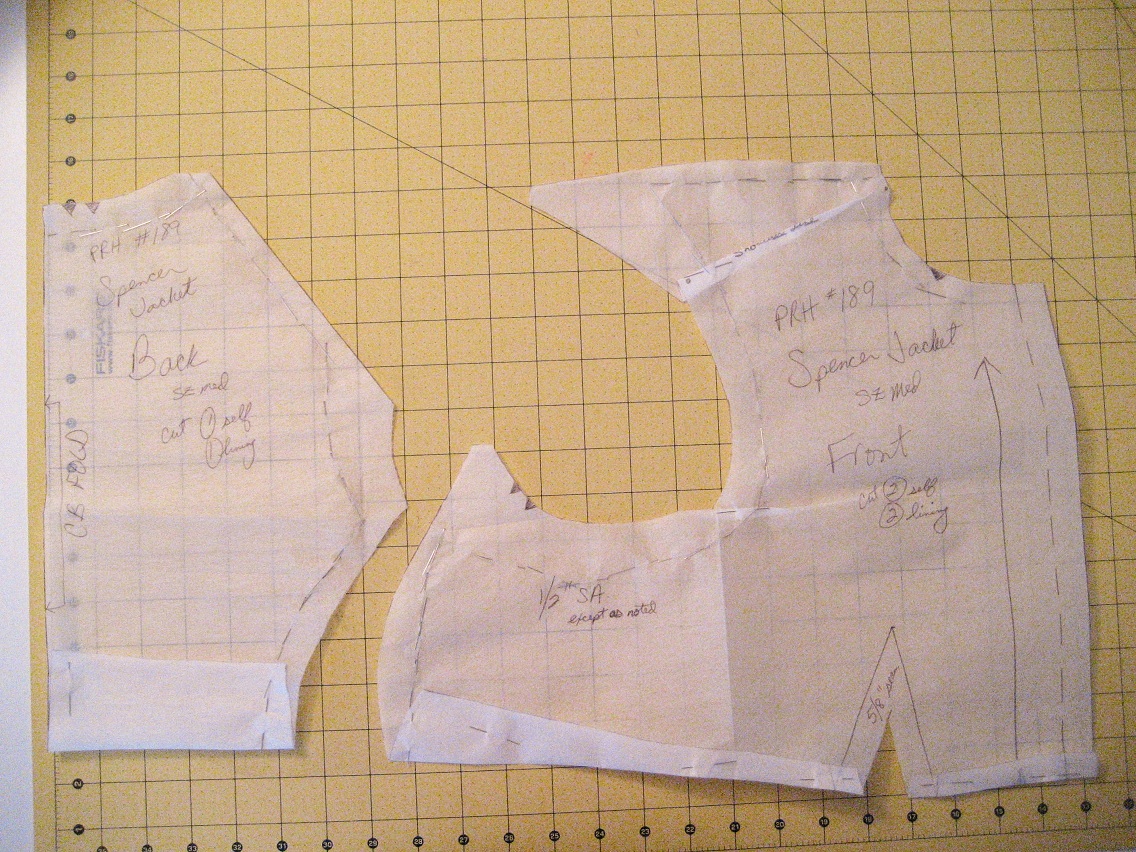
Can You Relate to Frustrating Sewing Patterns?
The jacket pattern has just stopped “working”….
You’ve made four bodice mockups and it *still* doesn’t look right.
You’ve had enough of the project because the pattern pieces are just not lining up.
The garment’s not coming out like you expected. It totally doesn’t look like the pattern envelope sketch and doesn’t come close to your vision in your head. You’re spitting fire, crying a river and throwing the whole darn thing across the room. Arrrrrrrgh!
Pattern Failure happens when:
- Seam lines don’t line up (or “Why is the front panel 2 inches shorter than the side?”)
- You have to guess where the dots are to match up that the instructions clearly state to connect and sew together but they’re nowhere to be found on the pattern pieces
- Or the instructions kindly forget to mention what those sets of dots are for. Do you match them up, line them up to something else, place trim here or embroider your initials?
- Oops! The collar piece is missing from the newly-released pattern
- The instructions fail miserably as if they were reproduced straight from a Victorian book. “Finish in the usual way.” As if!
I mean, isn’t that why you spent good money on the pattern? You expected the company would give you all the pieces needed to make this gorgeous 1904 gown, similar to the drawing on the front, and be very precise in actually *how* to put it all together. But somehow it’s just not coming out right.
The pattern becomes a disappointment. It doesn’t produce the results that you’re looking for. You might even go so far as to call the whole thing an Epic Fail.
Overcoming This Grand Catastrophe
One of the best ways to stop the fiasco is to put the project aside for a while to cool off. No doubt you’re upset and frustrated about it. Next time when you pick it up you’re refocused and ready to tackle it again. Stepping away from any project will give you fresh eyes when you come back to it. You might notice exactly how to fix the cutting error. Or discover a solution to the horrible seam placement.
Another way is to find a time to sit down with the pattern pieces and instructions and go over both together, step-by-step. You might have simply missed step #3b, but by doing so the whole thing becomes a mess. This isn’t technically “pattern failure” but it sure is easier to blame the “stupid” pattern rather than our inattention to important details.
Then again, some projects are just too far gone down the Epic Fail route that they’re not worth the effort to fix. These are the projects that teach us the limits of our skills but also exactly where we can improve our sewing….
The patience to make it right the first time… That one technique you’ve done a few times but still aren’t getting (or may never get to turn out)… Or the simple, pure joy that comes from the act of just getting to work on a sewing project for a brief time.
But what if you didn’t have to rely on published patterns and their infamous errors scattered throughout?
After sewing for years I didn’t think I’d ever be able to make something without a commercial pattern. I was SO dependent on them. Granted, my fashion school classes helped me break away from patterns, but the decision to try my hand at my own pattern designs and write the sewing instructions that I knew were in my head but never put on paper, gave me a BIG boost to cut the pattern apron strings.
I challenge you. If you’ve been sewing for a while, you know how to put a basic bodice together. If you’ve got a great fitting bodice, use that pattern again and make it up the same. You know how. Take that leap to try a skirt with only your head knowledge. You might be surprised.
But if you are still needing a hand-holding and depend upon patterns to guide you, that’s ok. Even the experienced will refer to books and other sources for reference.
If you would like another costumer’s trained mind to walk with you through the rough spots of your project, I invite you to take a look at our online sewing classes. Maybe just having someone point out a better way to accomplish that skirt pleating you’re working on will open the doors to other garments you’ve only dreamed about.
You CAN defeat pattern failure! I know you can create great things!


i had this same problem with a costume I made for my daughter, it turned into a two year nightmare of me going back and forth every couple of months to get it right. Mainly the skirt on it. The pieces wouldn’t line up properly with each other, actual costume pattern, and even when going step by little step everything would fall apart on me when trying to get the back center seam even on the multiple layers. Usually my husband would leave our joint work room when I started throwing pieces of fabric, raining pins everywhere, and screaming at it. Then I would pick everything up and put it away neatly for the next attempt. Which this year came together all at once. Not sure how or why, maybe the sewing gods took pity on me, but I sat down and finished not only the skirt but the rest of the outfit in a week. Some days you just have to walk away and not look at it for awhile. Good thing my daughters size didn’t change or I would have lost it right there and just had a bonfire in the backyard with that outfit as the starter.
Time out is important for certain projects at times. 😉
I think I’m almost at this point. Since I’m big even for a guy, literally no pattern works for me…I have to upsize everything.
And then get it to fit. And then my duct tape dress form I made isn’t actually representative (I think it got flat on the back).
I’ve been wrestling with this bodice for oh…months now. Same three pieces, over and over again. I _think_ I might be on the last one, and can finally make sure that the overskirt and the puff sleeves go on properly before I dive into the velvet (I’m definitely doing this on Hard Mode).
But I think that if this try doesn’t work I’m going to go and make the skirt from Scarlett O’Hara’s prayer dress since I could also use that as a petticoat for a gown I already have (and as you say, can’t have too many petticoats).
Oh, best of luck it getting it done!
I read patterns from Victorian fashion books and I look at the finished picture versus the pattern. And I’m lost.
I mean, did everyone back then know how to get from the vague-as-hell to the dress-of-your-dream?
Haha Gail! Sometimes it DOES seem that they all knew how to make up the most gorgeous of dresses from a plain line on a page. They took all their dressmaking secrets to the grave and now we’re having to muddle through the process of how they did it. 🙂
One of the Victorians and earlier secrets is that they were sewing from a very young age. At 5 and 6 they would be making dresses for their dolls or even the dolls them selves. Learning their ABC’s by doing samplers. In short they knew the patterns and how fabric works by the time they were teenagers. Most of us conversely don’t start sewing till we are grown up and have a lot of catching up to do.
I have made several of the Simplicity Civil War era dresses, but I make the same skirt over and over. I just know it works the best and I understand the instructions well enough to adapt to other patterns. I also learned to read through all the instructions before ever starting to sew. My sister taught me that. It makes things a lot easier to follow later on. Final piece of advice from my mother…just follow the instructions. Sometimes when I’m trying to visualize the fabric doing one thing the pattern is getting it to do something completely different. Sometimes (only sometimes) this does not work, but in general it does. Great article!
{Sorry – I did not proof the errors in my last comment! Please delete and post this one – Thank you!}
Yes – good advise indeed.
I have reshaped and cut out new pieces that fit better, not being able to justify the original pieces. The reasons can be pattern failure or more often, personal error – when re-sizing a pattern, we forget to follow suit with the rest of the pattern pieces that also need to be adjusted! I find that’s a big factor.
Beautiful sewing – although I am only interested in the modest necklines, etc., your work and advise is excellent.
I totally agree about the stepping away from a difficult sewing project. When I get to the screaming point I stop, get a cool drink and look out the window at the trees, birds, children, whatever is going on. Then after about a hour, I go back and it usually falls into place.
Thank you for the wonderful information, keep it comming.
Hi, Jennifer,
Thanks for your article on the frustrations of dealing with patterns and other sewing problems. I’ve been working on a medieval dress for a friend who wanted it made from stretch velvet. What a nightmare! I have had to set it aside several times during the process and come back to it later. Your article with its suggestions and encouragement came at just the right time.
Jody
Wow, great advice. Am sorta doing this now. Keeping things somewhat simple with my outfits n fits well with my character. Having a dress form really helps too